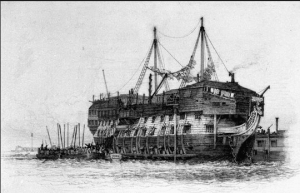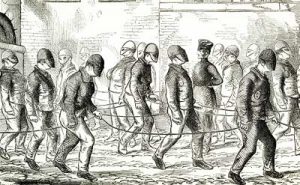no second chances
 The reasons that Britain decided to start a Penal Colony at Botany Bay, Australia are not fully agreed upon. Some say that that there were deeper motives than just a place to house their criminals. The soil at Botany Bay was perfect for growing flax. I suppose that the prisoners would need to be doing some kind of work as penance for their crimes. Nevertheless, Britain would be making a profit from the flax that was produced thee, and the bay was perfect for a port, which would be necessary to assist with trade. All in all, Botany Bay seemed like the best option for a penal colony for Britain, so the plans were put in place, and before long the penal colony became a reality.
The reasons that Britain decided to start a Penal Colony at Botany Bay, Australia are not fully agreed upon. Some say that that there were deeper motives than just a place to house their criminals. The soil at Botany Bay was perfect for growing flax. I suppose that the prisoners would need to be doing some kind of work as penance for their crimes. Nevertheless, Britain would be making a profit from the flax that was produced thee, and the bay was perfect for a port, which would be necessary to assist with trade. All in all, Botany Bay seemed like the best option for a penal colony for Britain, so the plans were put in place, and before long the penal colony became a reality.
When Governor Phillip arrived in 1788, he asked for carpenters, masons, bricklayers to help set up the colony, along with many tools of the trades. In January of 1788, the first 736 convicts banished from England to Australia arrived in Botany Bay. Over the next 60 years, approximately 50,000 criminals were transported from Great Britain to the Botany Bay in one of the strangest episodes in criminal-justice history. I think many of us have thought that some criminals should be place on a deserted island, but Britain basically did just that…with every criminal, it seems.
The accepted wisdom of the upper and ruling classes in 18th century England was that criminals were inherently defective. They did not believe criminals could be rehabilitated and that they simply required separation from the genetically pure, law-abiding citizens. Consequently, lawbreakers had to be either killed or exiled, because prisons were too expensive, and they criminals were not worth the money. With the American victory in the Revolutionary War, transgressors could no longer be shipped off across the Atlantic, so the English had to look for a colony in some other direction.
Captain Arthur Phillip, a tough but fair career naval officer, was charged with setting up the first penal colony in Australia. The convicts were chained beneath the deck during the entire hellish six-month voyage. The first voyage claimed the lives of nearly 10 percent of the prisoners, which remarkably proved to be a rather good rate. On later trips, up to a third of the unwilling passengers died on the way. These were not hardened criminals by any measure; only a small minority were transported for violent offenses. Among the first group was a 70-year-old woman who had stolen cheese to eat.
Although not confined behind bars, most convicts in Australia had an extremely tough life. The guards who volunteered for duty in Australia seemed to be driven by exceptional sadism. Even small violations of the rules could result in a punishment of 100  lashes with a whip. It was said that blood was usually drawn after five lashes, but they didn’t stop there. Convicts usually ended up walking home in boots filled with their own blood, if they could walk at all. Convicts who attempted to escape were sent to tiny Norfolk Island, 600 miles east of Australia. The conditions there were even more inhumane. The only hope of escape from the horror of Norfolk Island was a “game” in which groups of three prisoners drew straws. The short straw was killed as painlessly as possible and a judge was then shipped in to put the other two on trial, one playing the role of killer, the other as witness. I guess the only hope of escape was, in reality, death. There were no second chances for them.
lashes with a whip. It was said that blood was usually drawn after five lashes, but they didn’t stop there. Convicts usually ended up walking home in boots filled with their own blood, if they could walk at all. Convicts who attempted to escape were sent to tiny Norfolk Island, 600 miles east of Australia. The conditions there were even more inhumane. The only hope of escape from the horror of Norfolk Island was a “game” in which groups of three prisoners drew straws. The short straw was killed as painlessly as possible and a judge was then shipped in to put the other two on trial, one playing the role of killer, the other as witness. I guess the only hope of escape was, in reality, death. There were no second chances for them.

